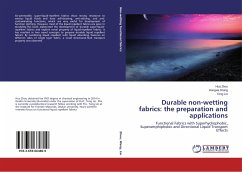This book suggests new insights into topographic characterization of polymer surfaces towards to physical-chemical and mechanistic understanding of wetting phenomena. The study is realized by an innovative methodology, separately considering different length scales in dependence on the surface morphologies. An important part of this book is the development of new concepts for surface characterisation of textile materials using different length scales, that makes possible to analyse separately their specific morphologies and to investigate the influence of topography on wettability by modification processes. This book shows how textile construction parameters control the topography and as a consequence influence capillarity. On the basis of experimental results, revealing differences in fabrics in respect to water penetration, the concept of an innovative wicking model is developed. A mathematical model for a virtual construction of surfaces to predict effects of topographic changes on the behaviour of polymer surfaces is presented. The method allows to simulate controlled changes in textile construction parameters and to study their effects on topography and wetting.
Bitte wählen Sie Ihr Anliegen aus.
Rechnungen
Retourenschein anfordern
Bestellstatus
Storno








